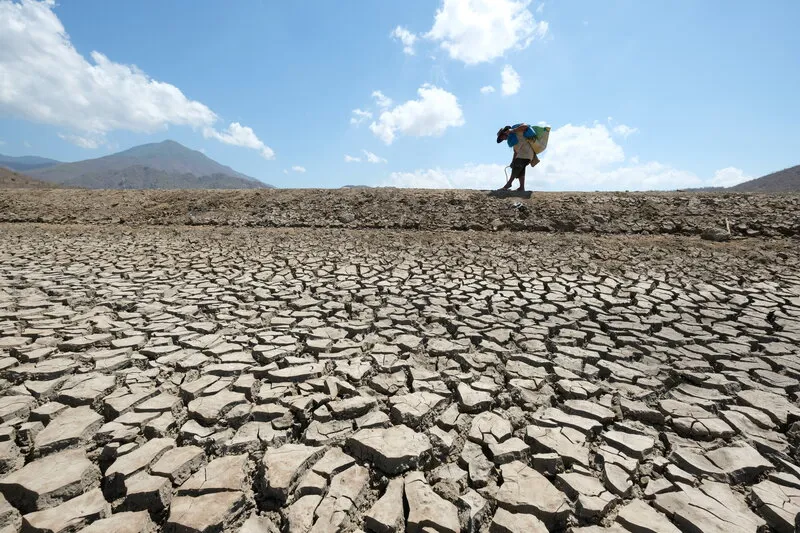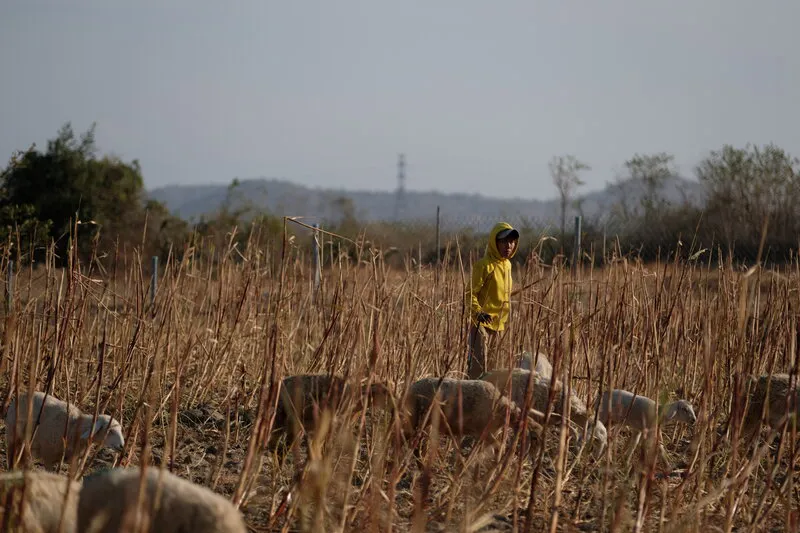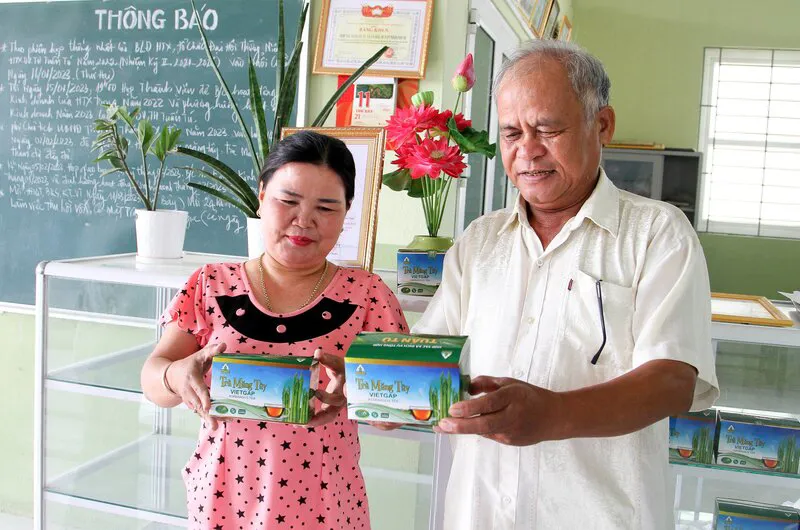Thriving against the odds: Vietnamese farmers prosper on arid and challenging land
Once a barren land where locals faced numerous challenges in their struggle to make a living and overcome poverty, it has undergone a remarkable transformation, thanks to flourishing asparagus farming.
"We can sleep well at night knowing that this farm guarantees a daily income of over VND500,000 (US$21)," Hung Ky, Chairman of the Board of Tuan Tu Farm Cooperative in Tuan Tu Village, Ninh Thuan Province, told The Hanoi Times, pointing to a sprawling asparagus farm covering over 1,000 square meters nearby.
| Ninh Thuan faced a severe drought in 2020. File photo |
What he said was beyond imagination not long ago for the locals, particularly the Cham ethnic group in the small town of An Hai Commune, Ninh Phuoc District in the south-central province of Ninh Thuan– a region defined by perpetual drought, abundant sunlight, and perennially scarce rainfall.
"Sand flies, sand jumps" is a common phrase used to describe agricultural landscapes in Ninh Thuan, and Tuan Tu Village is no exception. Despite the year-round hard work of farmers cultivating crops, poverty persists, and cactus bushes are the predominant vegetation in the area.
| Locals struggled to make ends meet, given the extreme weather conditions. File photo |
Recently, the village has experienced a facelift, brought about by the vibrant greenery of asparagus gardens.
"Before 2010, I was involved in cultivating peanuts, mustard greens, onions, and more. However, sustaining our livelihood was a constant challenge due to low productivity, extreme weather conditions, and fluctuating market prices," Ky shared.
Nao Van Xay, a local farmer from the same village, who was busy tending to the asparagus garden nearby, added, "About a decade ago, there were cacti and white sand in the village, which made it difficult for people to farm on this land. My family, like many others, worked as seasonal laborers and struggled to make ends meet.
| Chairman of the Board of Tuan Tu Farm Cooperative Hung Ky. File photo |
But today, the asparagus in Tuan Tu has transformed our lives. I even built a spacious house," he told The Hanoi Times.
Xay explained that asparagus can grow 10-15cm overnight, mainly at night. Harvesting is usually done around 5-6 am when the plants are still fresh, crisp, and have not yet bloomed.
“Notably intriguing, asparagus is selective about its soil preferences and typically thrives in sandy soil conditions,” Xay said.
As a nutritious vegetable, the market demand for asparagus is currently high, and the supply is often insufficient, particularly for export to foreign markets such as Taiwan (China) and Singapore, he continued.
| Nao Van Xay and his asparagus. Photo: Ngoc Mai/The Hanoi Times |
In Tuan Tu Village today, not only the families of Ky or Xay enjoy a stable income and accumulated wealth, but also all the Cham people who are members of the Tuan Tu Cooperative.
With the cooperative's asparagus cultivation area spanning 53 hectares and a fixed selling price agreed with the business of VND50,000 ($2)/kg, the revenue for each household and the cooperative as a whole is substantial, especially for farmers who have risen from humble beginnings.
"The average monthly income for a farmer in the cooperative could reach approximately VND15 million (US$617), which is significantly higher than the local average earnings [around VND6.41 million ($264) in 2022 according to official data]. This income is three to four times higher than what can be achieved by growing other vegetable crops on the same land," Ky said.
He added that the cooperative, which now has 84 members from its original 13, generates over VND10 billion ($412,000) in revenue per year.
| A joyful smile graces the face of a farmer. Photo: Ngoc Mai/The Hanoi Times |
As a pioneer of the asparagus farming model, he recounted how his family first experimented with planting four hectares of asparagus. After witnessing successful growth and adaptation to the local soil and climate conditions, he gradually expanded the area by an additional 2.4 hectares, investing over VND100 million ($4,118) annually in an economical sprinkler irrigation system. This initiative resulted in an income exceeding VND400 million ($16,473).
"Seeing my success in asparagus cultivation, many people in An Hai Commune invested in well-digging and drip irrigation. At present, asparagus has gradually replaced less productive crops such as peanuts, purple onions, and white cabbage," Ky said.
| Following the harvest, asparagus undergoes processing before being made available for sale. Photo: Ngoc Mai/The Hanoi Times |
Water transforms lives
A turning point for many was the implementation of a project aimed at improving local access to water sources. Funded by the Asian Development Bank (ADB) in 2019, with an estimated investment capital of VND120 billion ($5 million), the project centered on the creation of an advanced irrigation structure to cover 300 hectares of agricultural land in the An Hai Commune. This initiative significantly contributed to enhancing irrigation efficiency and water conservation in the region, especially in the area dedicated to safe vegetable production.
| Hung Ky feeds the fish at one of the 15 500 cubic-meter tanks financed by ADB. Photo: Ngoc Mai/The Hanoi Times |
Dang Kim Cuong, Director of the Ninh Thuan Department of Agriculture and Rural Development, stated: "The ADB provided funding for the construction of a pumping station to transfer water from the Tuan Tu dam to the desert land in Tuan Tu Village, along with 15 large-scale 500 cubic-meter tanks to effectively store and manage the water supply. With access to water, people have confidently invested in expanding asparagus cultivation."
"Through its partnership with ADB, Ninh Thuan has secured a combined loan worth VND1.35 trillion ($56.8 million) for five projects. Most of the province's preferential loans are directed towards enhancing irrigation infrastructure," he told The Hanoi Times.
Cuong noted that before the irrigation system, many areas in Ninh Thuan had untapped water resources, while others suffered from drought and aridity.
“As the most arid province in the country, Ninh Thuan faced significant challenges in agricultural production due to water scarcity. To address this issue, many people resorted to drilling underground wells for irrigation. However, this approach had adverse effects on both product quality and productivity, leading to lower yields.
| Tea products made from asparagus. Source: Ninh Phuoc District News |
“The situation has now changed, with water being distributed evenly based on the needs of farmers' crops," he added.
Cuong mentioned that the province will continue assisting the community in further expanding the asparagus cultivation area to 500 hectares. At the same time, plans are underway to establish a high-tech agricultural zone for cultivating safe vegetables.
"Asparagus has proven to be economically efficient, particularly when households collaborate to produce asparagus products that meet VietGAP and GlobalGAP quality standards and comply with export requirements for markets such as Singapore and Taiwan. This endeavor aims to provide long-term and sustainable livelihoods for the local population," he explained.
During a meeting between a delegation of ADB and Ninh Thuan’s authorities in early December, ADB Country Director in Vietnam Shantanu Chakraborty underscored the importance of prioritizing support for Vietnam in achieving climate change goals.
Specifically, there was an emphasis on projects aimed at enhancing water use efficiency in drought-affected provinces, an important initiative given Vietnam's current challenges with extreme weather conditions, he added.
Chairman of the Ninh Thuan Provincial People's Committee Tran Van Nam concurred with this perspective, asserting that Vietnam needs financial support from international organizations to carry out socio-economic development projects, especially at this stage of the country's development.
Nam mentioned that in the past, Ninh Thuan regarded the sun and wind as disadvantages. However, through the processes of integration and development, these elements have turned out to be advantages to be leveraged. Sun and wind are viewed as valuable resources, similar to gold and silver.
"Past challenges and difficulties are being transformed into opportunities and potential for the province to move forward. The province’s outlook is now bright and promising," Nam affirmed.



















